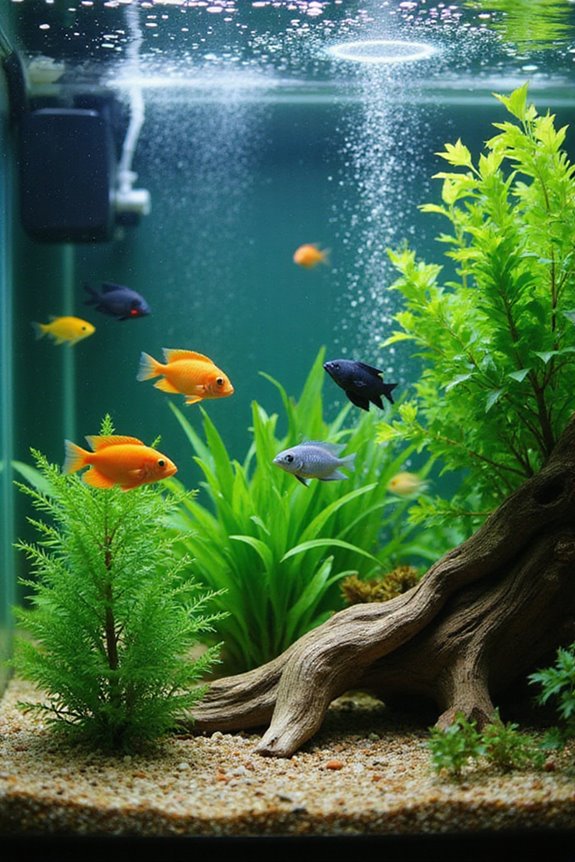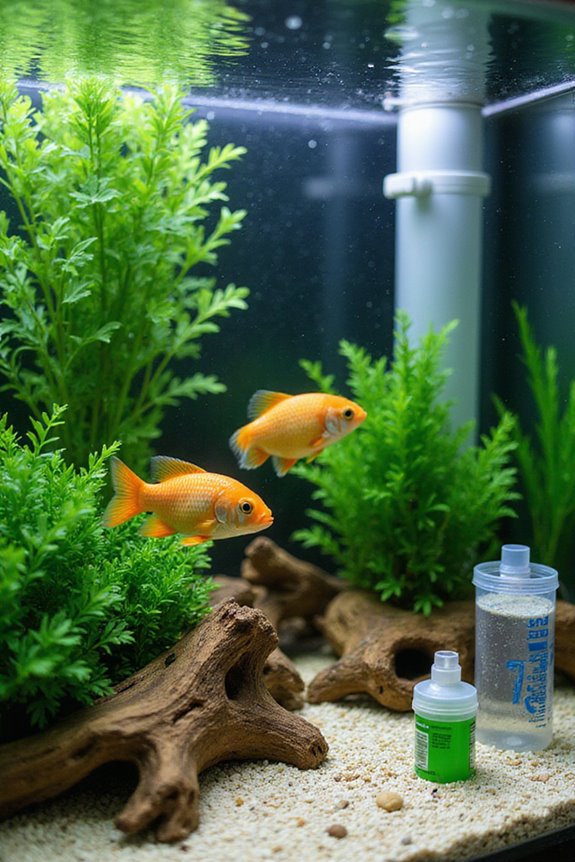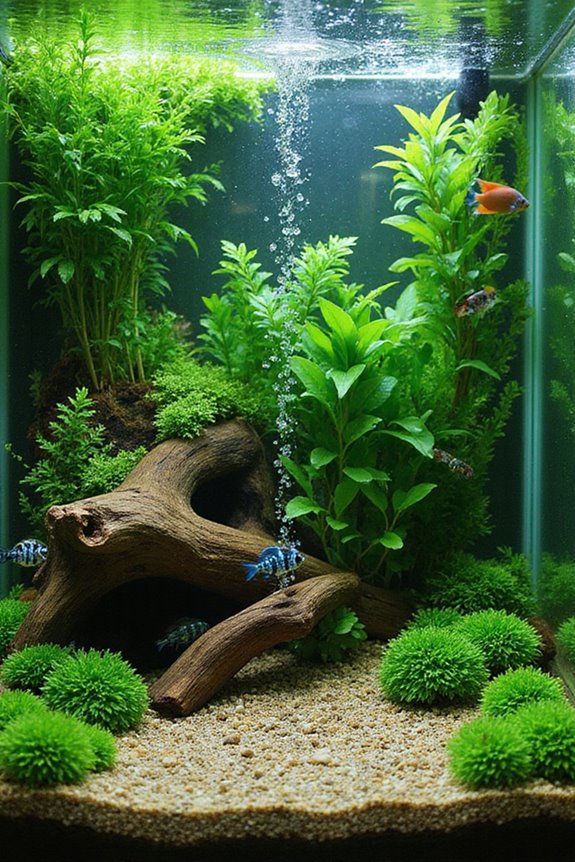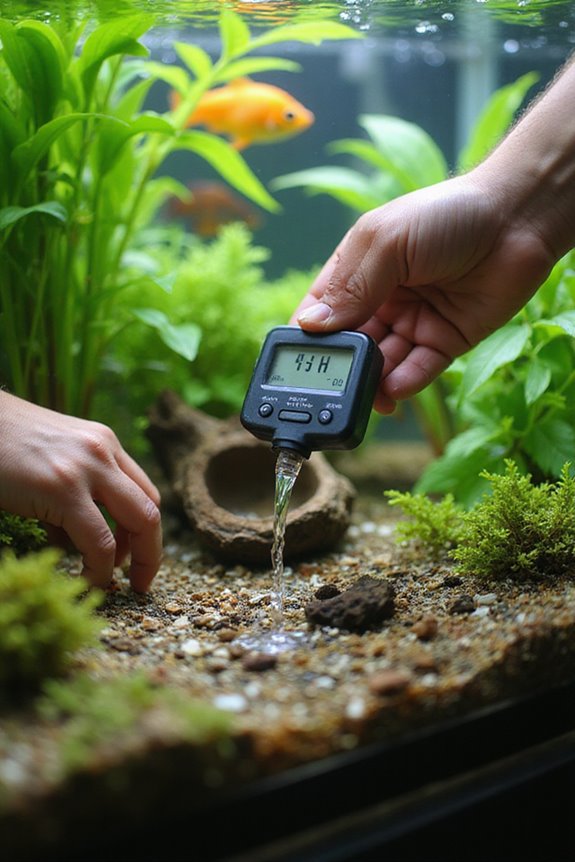To quickly reduce ammonia in your fish tank, I suggest doing a partial water change of 25%-50% to dilute ammonia levels. Treat the new water with a conditioner to neutralize chlorine. Introduce beneficial bacteria to help convert ammonia to nitrite, and then to nitrate. Remove any decaying materials and uneaten food. Implement regular water changes and monitor ammonia levels frequently. These steps will stabilize your tank and improve fish health. There are more detailed methods you can explore next.
Key Takeaways
- Perform a partial water change (25%-50%) to quickly dilute ammonia levels in the tank.
- Stop feeding fish temporarily to minimize ammonia spikes from uneaten food.
- Remove decaying material and uneaten food to reduce ammonia production in the aquarium.
- Use chemical detoxifiers like Prime or Amquel to temporarily neutralize ammonia concentrations.
- Introduce beneficial bacteria supplements to accelerate the cycling process for ammonia management.
Immediate Ammonia Reduction Techniques
When ammonia levels rise in your fish tank, it’s vital to act quickly to protect your aquatic life. First, perform a partial water change, replacing 25% to 50% of the water to dilute ammonia concentrations effectively. Always treat the new water with a conditioner to neutralize chlorine and chloramines. Next, stop feeding your fish temporarily, as uneaten food contributes to ammonia spikes. Regular ammonia testing is key to monitor levels during this process. Consider filtration upgrades, like adding a more powerful filter or multiple types, to enhance waste removal. Finally, remove any decaying material or uneaten food from the tank, as this can greatly reduce ammonia production. Consider installing an automatic fish feeder to prevent overfeeding when you’re away, as these devices offer customizable portion control that helps maintain water quality. These immediate techniques can stabilize your aquarium environment.
Biological Methods: Beneficial Bacteria and Cycling
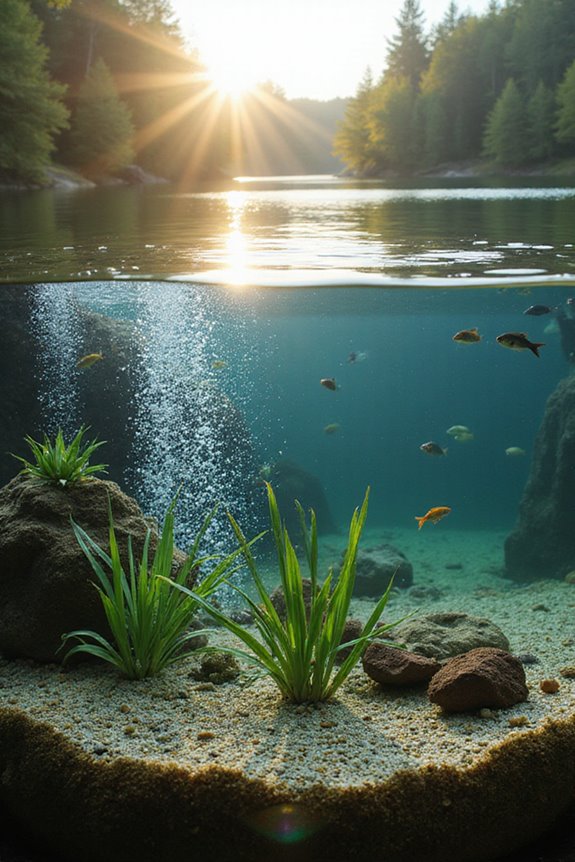
To effectively manage ammonia levels in your fish tank, establishing beneficial bacteria is important. These bacteria play a significant role in the nitrogen cycle, breaking down fish waste and uneaten food. Ammonia-oxidizing bacteria (AOB) convert toxic ammonia into nitrite, while nitrite-oxidizing bacteria (NOB) transform nitrite into less harmful nitrate. Bacterial colonization starts slowly, so it’s essential to introduce fish gradually and avoid overfeeding. Make sure your filter media stays clean but don’t replace it all at once; this preserves the bacteria. Consider using commercial nitrifying bacteria supplements to speed up the process. Maintaining stable ammonia levels below 5 ppm is vital for keeping these beneficial colonies healthy, therefore promoting a thriving aquarium ecosystem. For environmentally conscious aquarists, using biodegradable fishing lines in your tank maintenance routine can reduce plastic pollution if line breaks during cleaning.
Aquarium Maintenance Best Practices
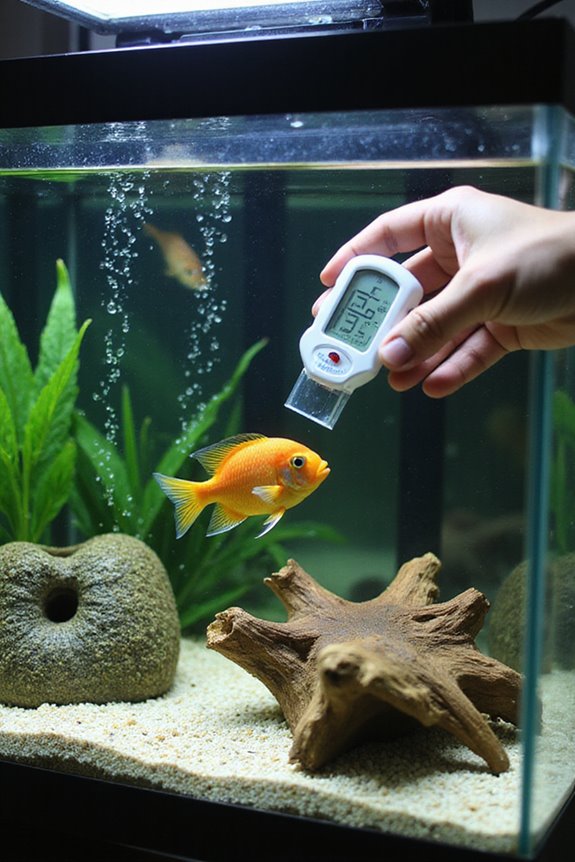
Maintaining an aquarium requires consistent attention to various tasks that guarantee a healthy environment for your fish. One major task is performing regular water changes. I recommend changing 10-25% of the water weekly or biweekly, using water that matches the tank’s temperature. Always treat tap water with a water conditioner to neutralize chlorine and ammonia. This practice dilutes toxins and prevents ammonia spikes.
Additionally, filter maintenance is essential. I clean or rinse the filter media monthly with tank water to preserve beneficial bacteria. Avoid using soap or tap water, as this can harm these vital colonies. Regularly inspect and replace filter cartridges to guarantee efficient filtration. In emergency situations, having a reliable emergency radio nearby can provide vital weather alerts that may affect power supply to your aquarium equipment. Keeping up with these practices helps maintain ideal water quality for your aquatic life.
Aquarium Plant Utilization
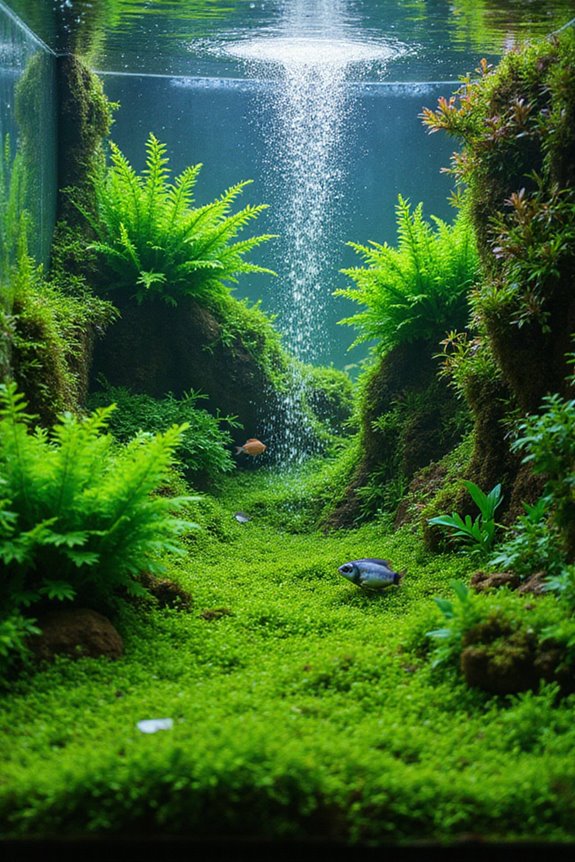
Aquarium plants play a significant role in managing ammonia levels, complementing routine maintenance practices. Selecting the right plants is essential; I recommend fast-growing species like hornwort, water sprite, and duckweed due to their high nitrogen absorption rates. These plants thrive in various locations, including floating positions, where they can quickly absorb nutrients from the water surface. Introducing hardy plants like Anubias and Java fern early in the cycling process also supports ammonia control. Pay attention to growth rates; faster-growing plants absorb ammonia more efficiently than slower varieties. By using a mix of plant types, you can establish a balanced ecosystem that effectively reduces ammonia stress on fish and keeps your aquarium healthy.
Stocking and Feeding Control
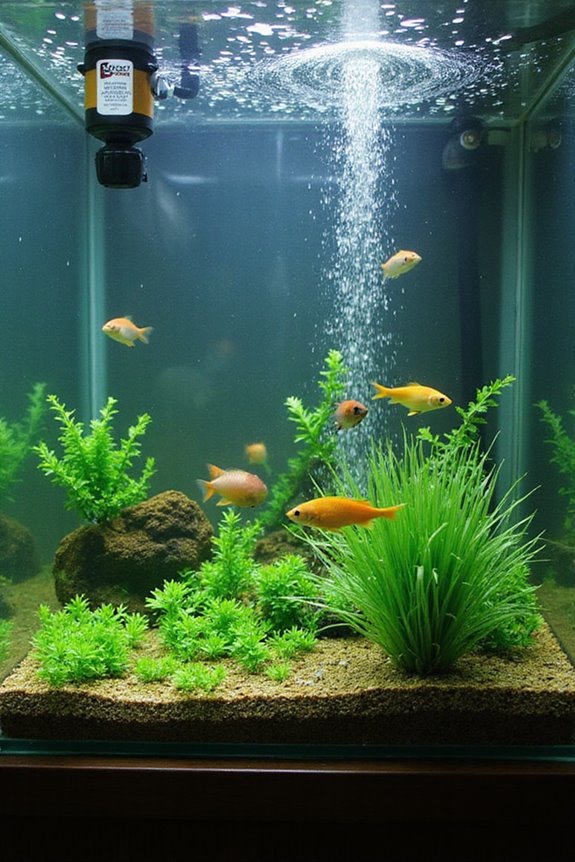
Effective stocking and feeding control are essential for maintaining low ammonia levels in your fish tank, especially since overstocking can quickly lead to increased waste and ammonia production. I recommend checking fish compatibility before adding new species, as different fish produce varying amounts of waste. Stick to the recommended stocking densities to promote a balanced environment.
When feeding, only provide what your fish can eat in a few minutes, and promptly remove any uneaten food to prevent decay. Adjust the portion size based on your fish’s size and activity level. Regular monitoring of fish populations and waste management practices will help keep ammonia levels stable, ensuring a healthy habitat for your aquatic life.
Emergency and Chemical Treatments
When ammonia levels rise in your fish tank, it’s crucial to act quickly with emergency and chemical treatments. I recommend using chemical detoxifiers like Prime or Amquel, which temporarily neutralize ammonia, binding it into a non-toxic form. This provides relief until your biological filtration stabilizes. Frequent dosing may be necessary if ammonia levels remain high. I also suggest performing immediate water changes of 20%-75% to dilute ammonia concentrations, ensuring the new water matches the tank’s temperature and pH. Additionally, consider using ammonia conditioners to control levels while maintaining oxygen with air stones. Remember, these treatments are temporary fixes; they don’t remove ammonia, so combine them with good filtration and regular monitoring for the best results.
Frequently Asked Questions
How Often Should I Test Ammonia Levels in My Tank?
I recommend testing ammonia levels daily while cycling your tank. It’s essential for monitoring water quality. Once stable, you can reduce testing frequency, but always keep an eye on those ammonia levels to protect your fish.
Can Ammonia Affect the Health of My Plants?
When I first noticed my plants turning yellow, I realized ammonia was affecting their health. It disrupts nutrient absorption, stunting plant growth. Keeping ammonia levels low is essential for thriving aquatic plants in my tank.
What Signs Indicate High Ammonia Levels in Fish?
I’ve noticed that signs of ammonia toxicity in fish behavior include gasping at the surface, scratching against objects, and unusual lethargy. These symptoms suggest distress, indicating that immediate action may be necessary for their health.
Are There Specific Fish Types More Tolerant to Ammonia?
I’ve found that ammonia resistant fish like Guppies and Corydoras catfish not only tolerate ammonia better but also offer great fish compatibility in community tanks. They’re perfect choices for less-than-ideal water conditions.
How Long Does It Take for Ammonia Detoxifiers to Work?
Ammonia detoxifiers usually start working almost immediately after application. I’ve noticed their efficacy lasts about 24 to 48 hours, so I always plan my detoxifier application timing to maintain safe levels consistently.

